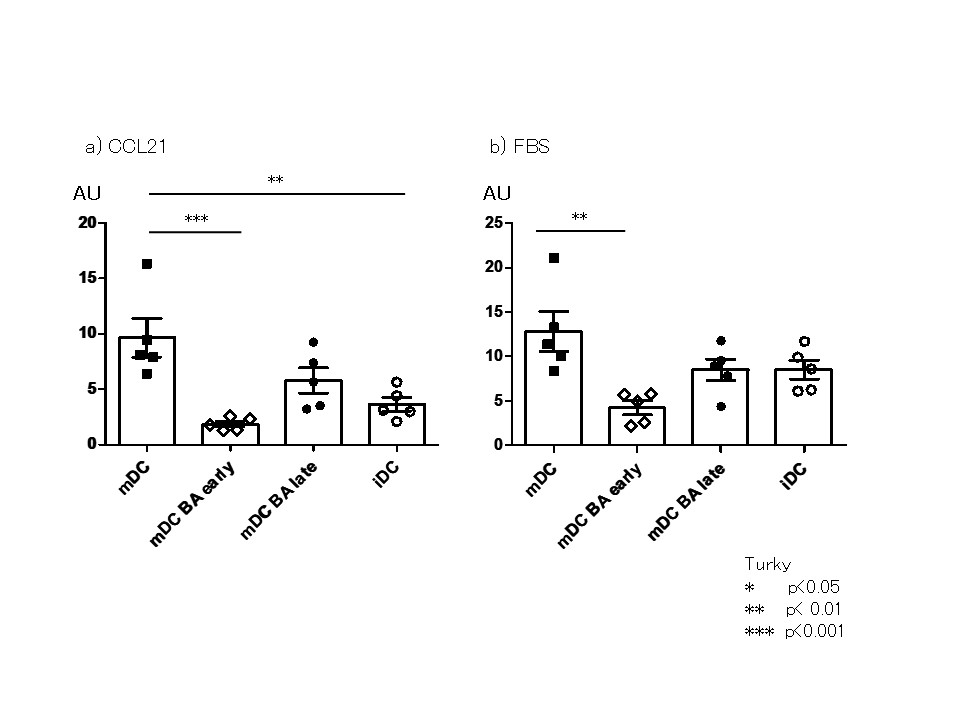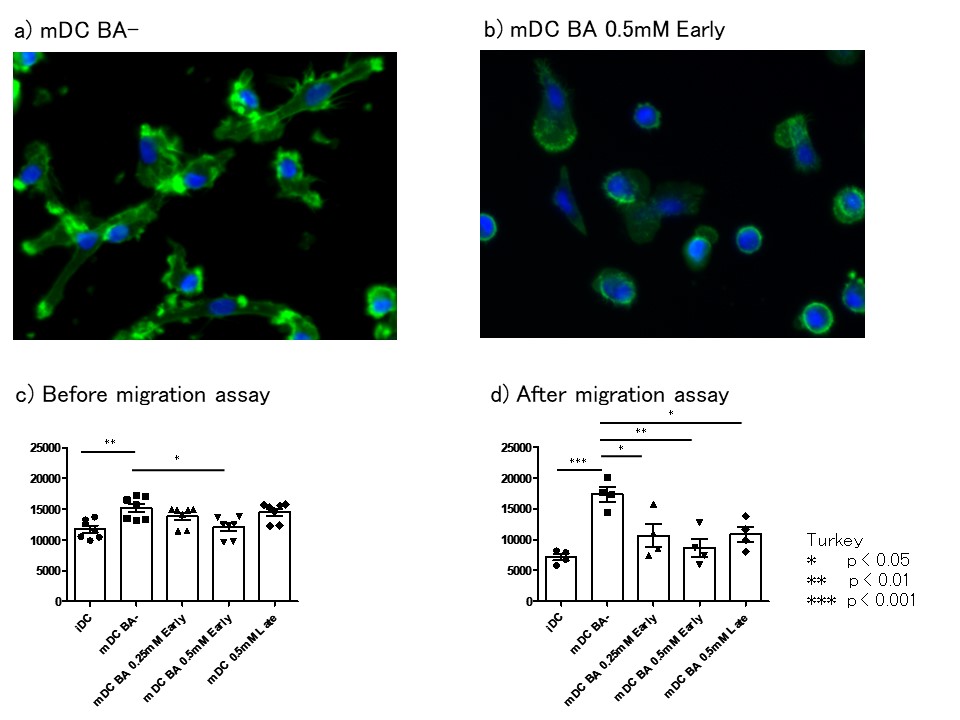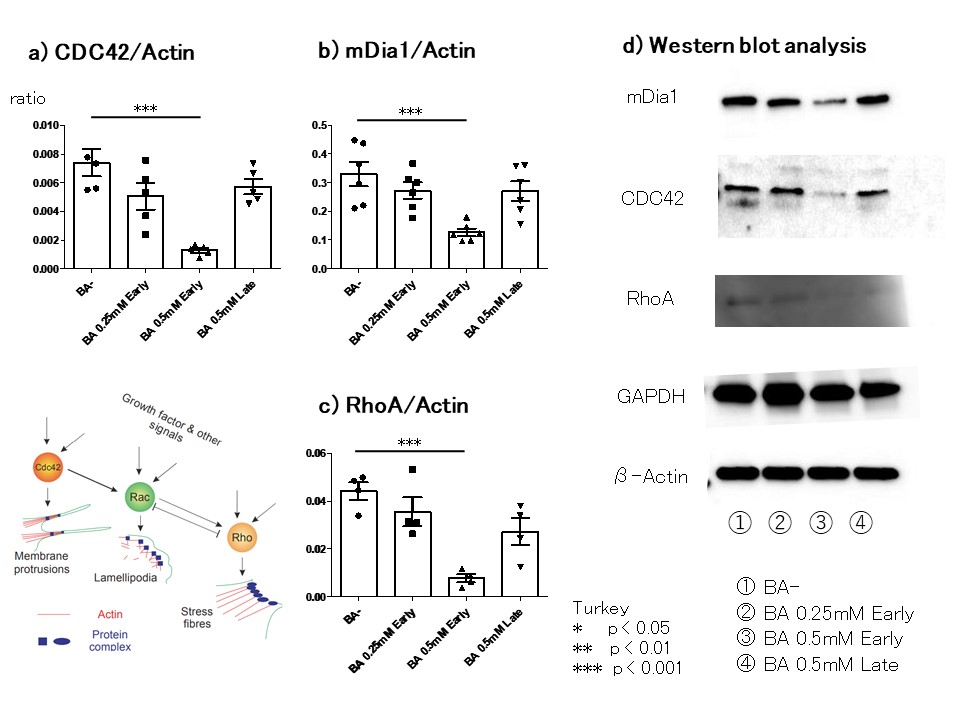Back
Poster Session D
Immunobiology
Session: (1681–1706) Innate Immunity Poster: Basic and Translational Science
1690: Butyric Acid Suppresses Migration of Human Monocyte Derived Dendritc Cell by Inhibiting Actin Polymerization via mDia1 Inhibition
Monday, November 14, 2022
1:00 PM – 3:00 PM Eastern Time
Location: Virtual Poster Hall
- TN
Takumi Nagamoto, MD
Kobe University
Kobe, Japan
Abstract Poster Presenter(s)
Takumi Nagamoto1, takaichi okano2, Yoshikazu Fujikawa3, Yuzuru Yamamoto2, Hirotaka Yamada2, Yo Ueda2, Sho Sendo4 and Jun saegusa2, 1Kobe University, Kobe, Japan, 2Kobe University, Rheumatology, Kobe, Japan, 3Hyogo Prefectural Harima-Himeji General Medical Center, Himeji, Japan, 4University California, San Diego (UCSD), La Jolla, CA
Background/Purpose: Butyric acid is known to improve chronic inflammation such as inflammatory bowel disease and arthritis. Dendritic cells activate in inflammatory condition, migrate to regional lymph nodes, and activate naive T cells.
In this study, we investigated the effect of butyric acid on the migration ability of monocyte-derived dendritic cells (moDC).
Methods: Human CD14+ Monocytes were purified by positive selection from PBMC using CD14 magnetic beads. Cells were cultured in the presence of GM-CSF (50 ng/ml) and IL-4 (20 ng/ml) for 5 days. After culturing for 5 days, cells were matured with LPS (1ug/ml) for 24 hours. Butyric acid was administered at different dose or period. Surface antigen on moDC was analyzed by flow cytometry (BD FACS VERSETM). Migration assay was performed on Boyden chamber CytoSelectTM 24-Well Cell Migration Assay (5um). Actin was stained with Alexa Fluor® 488 Phalloidin before and after migration assay. After administration with butyric acid assigned to each period and concentration, moDC were lysed for western blot analysis for evaluating signaling. Chemiluminescent signals were detected and calculated by AmershamTM Imager.
Results: We demonstrated that butyric acid decreased the CCR7 expression of moDC, which has a key role in DC homing to the lymph nodes and intestinal Peyer's patches. We also showed that butyric acid decreased the migration ability of moDC. Furthermore, moDCs cultured with butyric acid showed a round shape and poor formation of dendrites and pseudopodia. Then we studied the effect of butyric acid on cytoskeleton, which plays an important role in migration and pseudopodia formation of DCs. Polymerized Actin (F-Actin) staining revealed that butyrate suppressed actin polymerization of moDC in a dose dependent manner. CDC42 works important role of lamellipodia and membrane protrusions. RhoA is upstream of mDia1, and mDia1 was reported to accelerate actin nucleation and elongation. We revealed that butyric acid decreased the protein expression of mDia1, RhoA, and CDC42, while beta actin was not downregulated, by Western blot analysis.
Finally, we administered Rho/Rac/CDC42 activator I (CN04), it robustly increases the level of GTP-bound RhoA, Rac1 and CDC42 by deamidating glutamin-63 of Rho and glutamin 61 of Rac and CDC42 in their respective Switch II resions. CN04 restored the migration ability od moDC reduced by butyric acid.
In summary, butyric acid changed cell morphology and decreased migration ability by inhibiting Actin polymerization. Butyric acid suppressed the expression of RhoA, CDC42 and mDia1 and inhibited polymerization of Actin. CN04 abrogated the inhibitory effect of butyric aci on moDC migration. Butyric acid impairs antigen presentation by inhibiting Dendritic Cell migraion and maybe involved in tolerance such as in the intestinal tract.
Conclusion: Butyric acid suppresses migration of monocyte derived Dendritic Cell by inhibiting Actin polymerization via mDia1 inhibition. Butyric acid impairs antigen presentation by inhibiting Dendritic Cell migraion and may be involved in tolerance.
 Butyric acid inhibited migration of moDC.
Butyric acid inhibited migration of moDC.
a) Butyric acid inhibited migration of moDC for CCL21.
b) Butyric acid inhibited migration of moDC for FBS.
All data are presented as mean±sem.
P < 0.05; **P < 0.01, *** P < 0.001 Based on Turky
 Butyric acid inhibited Actin polymerization.
Butyric acid inhibited Actin polymerization.
a, b) F-Actin staing by Alexa flour 488 conjugated phalloidin revealed that Butyric acid changed cell morphology. moDC cultured with butyric acid showed a round shape and poor formation of dendrites and pseudopodia.
c, d) Butyric acid inhibited Actin polymerization of moDC especially after migration. MFI was measured by FACS VERSE.
All data are presented as mean±sem.
P < 0.05; **P < 0.01, *** P < 0.001 Based on Turky
 Butyric acid suppressed the expression of CDC42, mDia1, and RhoA.
Butyric acid suppressed the expression of CDC42, mDia1, and RhoA.
a, b, c, d) Western blot analysis revealed that butyric acid suppressed the expression of CDC42, mDia1, and RhoA, while beta Actin was not downregulated.
Chemiluminescent signals were detected and calculated by Amersham Imager.
All data are presented as mean±sem.
P < 0.05; **P < 0.01, *** P < 0.001 Based on Turky
Disclosures: T. Nagamoto, None; t. okano, None; Y. Fujikawa, None; Y. Yamamoto, None; H. Yamada, None; Y. Ueda, None; S. Sendo, None; J. saegusa, None.
Background/Purpose: Butyric acid is known to improve chronic inflammation such as inflammatory bowel disease and arthritis. Dendritic cells activate in inflammatory condition, migrate to regional lymph nodes, and activate naive T cells.
In this study, we investigated the effect of butyric acid on the migration ability of monocyte-derived dendritic cells (moDC).
Methods: Human CD14+ Monocytes were purified by positive selection from PBMC using CD14 magnetic beads. Cells were cultured in the presence of GM-CSF (50 ng/ml) and IL-4 (20 ng/ml) for 5 days. After culturing for 5 days, cells were matured with LPS (1ug/ml) for 24 hours. Butyric acid was administered at different dose or period. Surface antigen on moDC was analyzed by flow cytometry (BD FACS VERSETM). Migration assay was performed on Boyden chamber CytoSelectTM 24-Well Cell Migration Assay (5um). Actin was stained with Alexa Fluor® 488 Phalloidin before and after migration assay. After administration with butyric acid assigned to each period and concentration, moDC were lysed for western blot analysis for evaluating signaling. Chemiluminescent signals were detected and calculated by AmershamTM Imager.
Results: We demonstrated that butyric acid decreased the CCR7 expression of moDC, which has a key role in DC homing to the lymph nodes and intestinal Peyer's patches. We also showed that butyric acid decreased the migration ability of moDC. Furthermore, moDCs cultured with butyric acid showed a round shape and poor formation of dendrites and pseudopodia. Then we studied the effect of butyric acid on cytoskeleton, which plays an important role in migration and pseudopodia formation of DCs. Polymerized Actin (F-Actin) staining revealed that butyrate suppressed actin polymerization of moDC in a dose dependent manner. CDC42 works important role of lamellipodia and membrane protrusions. RhoA is upstream of mDia1, and mDia1 was reported to accelerate actin nucleation and elongation. We revealed that butyric acid decreased the protein expression of mDia1, RhoA, and CDC42, while beta actin was not downregulated, by Western blot analysis.
Finally, we administered Rho/Rac/CDC42 activator I (CN04), it robustly increases the level of GTP-bound RhoA, Rac1 and CDC42 by deamidating glutamin-63 of Rho and glutamin 61 of Rac and CDC42 in their respective Switch II resions. CN04 restored the migration ability od moDC reduced by butyric acid.
In summary, butyric acid changed cell morphology and decreased migration ability by inhibiting Actin polymerization. Butyric acid suppressed the expression of RhoA, CDC42 and mDia1 and inhibited polymerization of Actin. CN04 abrogated the inhibitory effect of butyric aci on moDC migration. Butyric acid impairs antigen presentation by inhibiting Dendritic Cell migraion and maybe involved in tolerance such as in the intestinal tract.
Conclusion: Butyric acid suppresses migration of monocyte derived Dendritic Cell by inhibiting Actin polymerization via mDia1 inhibition. Butyric acid impairs antigen presentation by inhibiting Dendritic Cell migraion and may be involved in tolerance.
 Butyric acid inhibited migration of moDC.
Butyric acid inhibited migration of moDC.a) Butyric acid inhibited migration of moDC for CCL21.
b) Butyric acid inhibited migration of moDC for FBS.
All data are presented as mean±sem.
P < 0.05; **P < 0.01, *** P < 0.001 Based on Turky
 Butyric acid inhibited Actin polymerization.
Butyric acid inhibited Actin polymerization.a, b) F-Actin staing by Alexa flour 488 conjugated phalloidin revealed that Butyric acid changed cell morphology. moDC cultured with butyric acid showed a round shape and poor formation of dendrites and pseudopodia.
c, d) Butyric acid inhibited Actin polymerization of moDC especially after migration. MFI was measured by FACS VERSE.
All data are presented as mean±sem.
P < 0.05; **P < 0.01, *** P < 0.001 Based on Turky
 Butyric acid suppressed the expression of CDC42, mDia1, and RhoA.
Butyric acid suppressed the expression of CDC42, mDia1, and RhoA.a, b, c, d) Western blot analysis revealed that butyric acid suppressed the expression of CDC42, mDia1, and RhoA, while beta Actin was not downregulated.
Chemiluminescent signals were detected and calculated by Amersham Imager.
All data are presented as mean±sem.
P < 0.05; **P < 0.01, *** P < 0.001 Based on Turky
Disclosures: T. Nagamoto, None; t. okano, None; Y. Fujikawa, None; Y. Yamamoto, None; H. Yamada, None; Y. Ueda, None; S. Sendo, None; J. saegusa, None.

